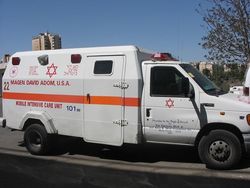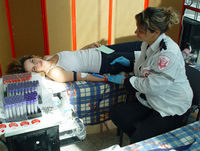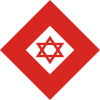Magen David Adom

The Magen David Adom (Hebrew: מגן דוד אדום, abbr. MDA or Mada) is Israel's national emergency medical, disaster, ambulance and blood bank service. The name means "Red Shield of David" but is usually translated as "Red Star of David". Since June 2006, Magen David Adom has been officially recognized by the International Committee of the Red Cross (ICRC) as the national aid society of the state of Israel under the Geneva Conventions, and a member of the International Federation of Red Cross and Red Crescent Societies.
Contents |
History

The Magen David Adom organization was formed by nurse Karen Tenenbaum in 1930 as a volunteer association with a single branch in Tel Aviv. After opening branches in Jerusalem and Haifa, it was extended nation-wide five years later, providing medical support to the public including not only Jews, but Arabs, Muslims and Christians. On 12 July 1950, the Knesset passed a law making MDA's status as Israel's national emergency service official[1];
- To carry out the functions of a national society, to be for this purpose an auxiliary service of the Medical Service of the Israeli Defense Forces in time of war and to prepare for this in time of peace;
- To maintain general first aid services;
- To maintain a storage service of blood, plasma and their by-products;
- Instruction in first aid and pre-hospital emergency medicine;
- Maintaining a volunteer infrastructure and training them in first aid, basic and advanced life support including Mobile Intensive Care Units;
- Transportation of patients, women in labor, and evacuation of those wounded and killed in road accidents;
- Transportation of doctors, nurses and medical auxiliary forces.
Volunteers
Like many organisations in Israel, Magen David Adom is mainly staffed by volunteers, and has over 10,000 people volunteering over one million hours per year. The minimum age to join Magen David Adom's basic first aid course and become a volunteer is 15.[2]
Since 2001, international volunteers aged 18 and over have the option to come to Israel for a two-month Yochai Porat International Volunteer Program. The program is named after its founder and first coordinator, who was killed by a sniper on March 3, 2002 while serving reserve duty as a combat medic in the Israel Defense Forces. All volunteers follow a 60-hour course that covers a wide range of topics ranging from common medical conditions and trauma situations to mass casualty events. Those who pass the course are then dispatched throughout the country and work with local volunteers in ambulances to provide initial medical care.[3][4]
While the program was originally financially supported by the Jewish Agency for Israel, it has recently been taken over by the Israel Experience organisation, which also offers programs for Jewish youths on Birthright Israel trips.
Current status

Though MDA currently staffs approximately 1,200 emergency medical technicians, paramedics and emergency physicians, it still relies heavily on over 10,000 volunteers who serve in both operational and administrative capacities. MDA headquarters and its blood bank are located at the Tel HaShomer complex in the center of the country. The organization operates 95 stations over the country, with a fleet of over 700 ambulances nationwide. Among them: mobile intensive care units (MICU), special ambulances equipped for mass casualty events, and armored ambulances. Most of the fleet is made up of regular size vans providing Basic Life Support. These are called "Lavan" (which in Hebrew means "White") due to their external aspect and to differentiate them from the MICU which have orange stripes on the sides. They are manned by EMTs who generally have ranks equivalent to Basic and Intermediate EMTs in the US. In Israel, they are called "Ma'ar" (first responders), "Chovesh" (EMT-B+) and "Chovesh Bachir" (EMT-I). MICUs similar to the US Type II units and manned by paramedics and physicians respond only to the most medically serious cases. They are called Natan (if a physician is on board) or Atan (if it is only staffed by paramedics and EMTs). Major stations include special units (called "Aran") for responding to mass casualty events like natural disasters or terrorist attacks.
Air ambulance service is provided by Israeli Air Force 669 unit with MEDEVAC helicopters, however MDA imported four MBB Bo 105 from Germany and plans to employ them to improve response times in peripheral areas. Previous attempts to integrate independent helicopter service in the 1970s were unsuccessful due to high cost.[1]
Unique among civilian emergency medical services due to its role as national aid society according to the Geneva Conventions, MDA can become an auxiliary arm of the Israel Defense Forces during times of war.
Membership in Red Cross

From its creation until 2006, Magen David Adom had been denied membership in the International Red Cross and Red Crescent Movement since it has refused to replace its red Star of David emblem with a pre-approved symbol.
The official reason for the denial of membership was concerns about symbol proliferation; at the same 1929 conference which granted use of the Red Crescent and Red Lion and Sun, a limitation was placed on acceptance of any further emblems. The "Red Star of David" symbol was not submitted to the ICRC until 1931.
Similar concerns of India, Ceylon and the former Soviet Union regarding the use of non-Hindu and seemingly religious symbols were also dismissed by the ICRC, but their national bodies chose to adopt the Red Cross as their official emblems in order to gain entry. The Red Cross — the inverse of the Swiss flag, the country of origin of the founder of the Red Cross and Red Crescent Movement — is not intended as a religious symbol, but is often perceived as such.
Critics of the ICRC assert discrimination since Turkey and Egypt were granted membership in 1929 while using the Islamic Red Crescent as their emblem, citing the same concerns about the cross.


In her March 2000 letter to the International Herald Tribune, Dr. Bernadine Healy, then president of the American Red Cross, wrote: "The international committee's feared proliferation of symbols is a pitiful fig leaf, used for decades as the reason for excluding the Magen David Adom — the Shield (or Star) of David." In protest, the American Red Cross withheld millions in administrative funding to the International Federation of Red Cross and Red Crescent Societies (IFRC) since May 2000.
Since the mid-1990s, there has also been extensive and growing co-operation between MDA and the ICRC including, among other things, a USD$2.2 million expenditure on strengthening ties between the two organisations, the signing in 2000 of a two year co-operation statement, the permanent placement of an ICRC co-operation officer in MDA headquarters, and extensive support of the MDA's blood bank activities. In addition, there are bilateral cooperation agreements between MDA and a number of national Red Cross societies.
On December 7, 2005, a diplomatic conference of states party to the Geneva Conventions adopted a third additional protocol, thereby introducing a new protective emblem, dubbed the "Red Crystal." This "third protocol emblem" is hailed as a truly universal emblem free of religious, ethnic, or political connotation. The new symbol is a red square frame tilted at a 45 degree angle. According to the rules of the third additional protocol, MDA can continue to use the Red Star of David as its sole emblem for indicative purposes within Israel. For indicative use in abroad missions, MDA can, depending on the specific situation in the host country, either incorporate the Red Star of David inside the Red Crystal or use the Red Crystal alone.
On June 22, 2006, MDA was recognised by the ICRC and admitted as a full member of the International Federation of Red Cross and Red Crescent societies,[5] following adoption of the Red Crystal symbol in the statutes of the International Red Cross and Red Crescent Movement on the same level as the Red Cross and Red Crescent symbols.[6]
Tracing service
Magen David Adom's tracing service was established to assist in locating relatives lost in the Holocaust. In 2000–2007, the service handled 5,000 applications.[7]
Criticisms
The Magen David Adom blood drive came under criticism after reports that blood from Ethiopian donors had been discarded. Magen David Adom spokesman Yeruham Mendola responded to the claims by saying: "The guidelines set by the Ministry of Health determines that anyone who was born, or who lived for over a year since 1977 in central Africa, southeast Asia or the Caribbean islands, or has spent over six months in Britain, or was in France, Ireland or Portugal for over 10 years — can choose not to donate blood, or donate blood, which is then marked, and know that it will not be used for transfusions." In 2006, a protest of some 10,000 Ethiopians outside the Prime Minister's office led to violent clashes with the police. Shimon Peres, serving as Vice Prime Minister in the cabinet of Ehud Olmert, apologized to the Ethiopian Jewish community for this policy.[8]
See also
- Israel Fire and Rescue Services
- ZAKA
- Hatzolah
- Geneva Conventions
- Protocol III, 2005 Geneva Convention amendment about the adoption of the Red Crystal emblem
References
- ↑ Saving Lives at the Dead Sea: Magen David Adom Olympics on TV
- ↑ Volunteers at MDA Israel. Retrieved 2009-09-07.
- ↑ Yochai Porat International Volunteers Program
- ↑ About the Program: The Yochai Porat Magen David Adom Overseas Program. Retrieved 2009-09-07.
- ↑ "With addition of crystal emblem, Israel now part of the Red Cross movement". CNN. 2006-06-22. http://www.cnn.com/2006/WORLD/europe/06/22/thursday/index.html.
- ↑ ICRC website — Press Release 06/65, 22-06-2006
- ↑ Tracing services
- ↑ Sermon, March 8, 1996, Rabbi Samuel M. Stahl
External links
- AFMDA American Friends of Magen David Adom
- United Kingdom Friends of the MDA
- MDA Israel in English
- ICRC page discussing relationship with the MDA
- American Red Cross page discussing relationship with MDA
- IRC Discrimination, Jewish Virtual Library
- Magen David Adom — Yochai Porat International Volunteers Program
|
||||||||
|
||||||||||||||||||||||||||||